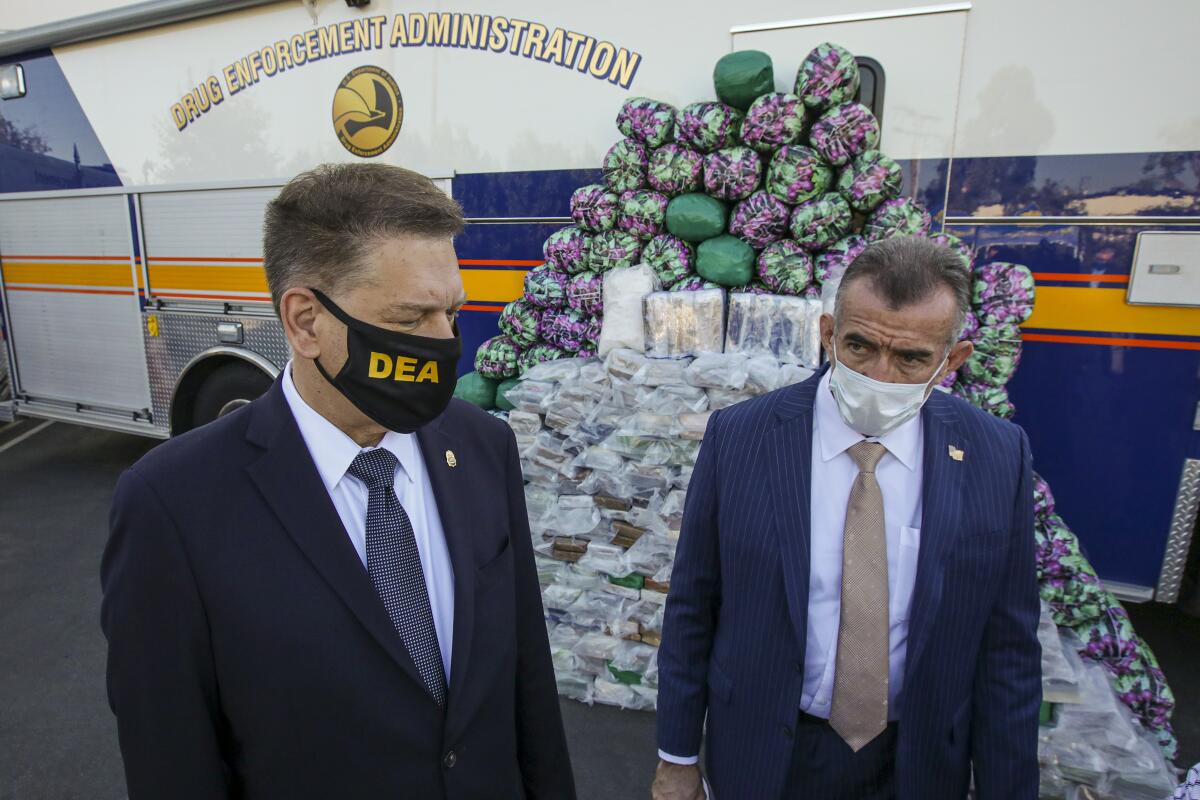Washington has to help with L.A.’s meth addiction

- Share via
Although opioids — especially oxycodone and fentanyl — dominate addiction news, another deadly drug has been lurking in the background, causing tens of thousands of fatalities: methamphetamine.
Meth addiction isn’t new, but it has quickly emerged in recent years as a particularly deadly threat, and Los Angeles has been hard-hit.
Between 2008 and 2018, meth-related deaths in L.A. increased tenfold, from 43 to 435, according to county statistics. By 2018, meth was involved in 44% of all drug overdose deaths in Los Angeles County.
Last summer, Mark Casanova, of Homeless Health Care Los Angeles, told The Times that meth accounted for 70% of drug use among L.A.’s homeless population. Between 2005 and 2019, according to county data, more than 185,000 individuals who entered publicly funded treatment programs in Los Angeles were admitted for meth.
“It’s way cheaper [than many other street drugs], it lasts longer, you can smoke it or inject it, it’s easy to get,” Casanova said.
In September, Sen. Charles E. Grassley (R-Iowa) and I introduced the Methamphetamine Response Act. The bill, which would direct the White House Office of National Drug Control Policy to develop and implement a plan to address the growing use of meth, passed the Senate in November. Unfortunately, the House has not yet addressed the bill and likely will not pass it before the 116th Congress ends.
What did pass the House and Senate, as part of the massive omnibus end-of-year legislation that was signed into law Sunday, was a directive to the drug control policy office to finalize regulations for designating emerging drug threats. The office began the process in May; now it should finish that work as quickly as possible.
The meth surge isn’t confined to California, of course. According to an analysis by researchers at the Centers for Disease Control and Prevention, between 2008 and 2017, the number of people admitted nationwide for meth-related treatment rose from 260,000 to 373,000, a 43% increase. And the number admitted for meth treatment who were also using heroin increased from nearly 14,000 to more than 88,000, a stunning 530% increase. Such multiple-substance use exacerbates the dangers.
By the end of 2019, Drug Enforcement Administration data show meth availability was growing as street prices declined. Those increases continued this year even as prices started to rise again and much of the country faced public health restrictions due to COVID-19. And between March and May of this year, one lab found that nationwide urine drug testing positivity rates for meth increased by approximately 20%.
We’re also seeing larger drug busts — again particularly in California, where the majority of meth interdictions at ports of entry occur. In October, U.S. Customs and Border Protection seized 3,000 pounds at the port of Otay Mesa, and the DEA seized 2,224 pounds of meth in Riverside County. Both seizures are among the largest on record for the agencies and indicate growing demand for the drug.
What Washington must do to address this crisis was laid out in the Methamphetamine Response Act.
First, the drug control policy office should declare meth an emerging drug threat. Based on the use and death statistics, it’s clear that it meets the criteria, and as such, it should trigger a government-wide response.
Second, the office must develop and implement a plan that is specific to meth. Addiction is complex, and while a crucial component of the overall U.S. strategy is to reduce the flow of drugs, the problem cannot be solved through law enforcement efforts alone.
That’s why, in addition to providing an assessment of the current availability of meth, the policy office must set short- and long-term goals focused on reducing demand, which means expanding prevention and treatment programs, as well as on reducing supply. To ensure accountability, the meth plan should also include performance measures related to those goals.
We know that fentanyl and other opioids are ravaging our country and that we must do all we can to prevent this, but we can’t ignore the risks that other drugs pose in the process.
We must act now to prevent methamphetamine from turning into a full-blown national epidemic. This is a problem that won’t go away on its own.
Dianne Feinstein, a Democrat, is the senior U.S. senator from California.
More to Read
A cure for the common opinion
Get thought-provoking perspectives with our weekly newsletter.
You may occasionally receive promotional content from the Los Angeles Times.









